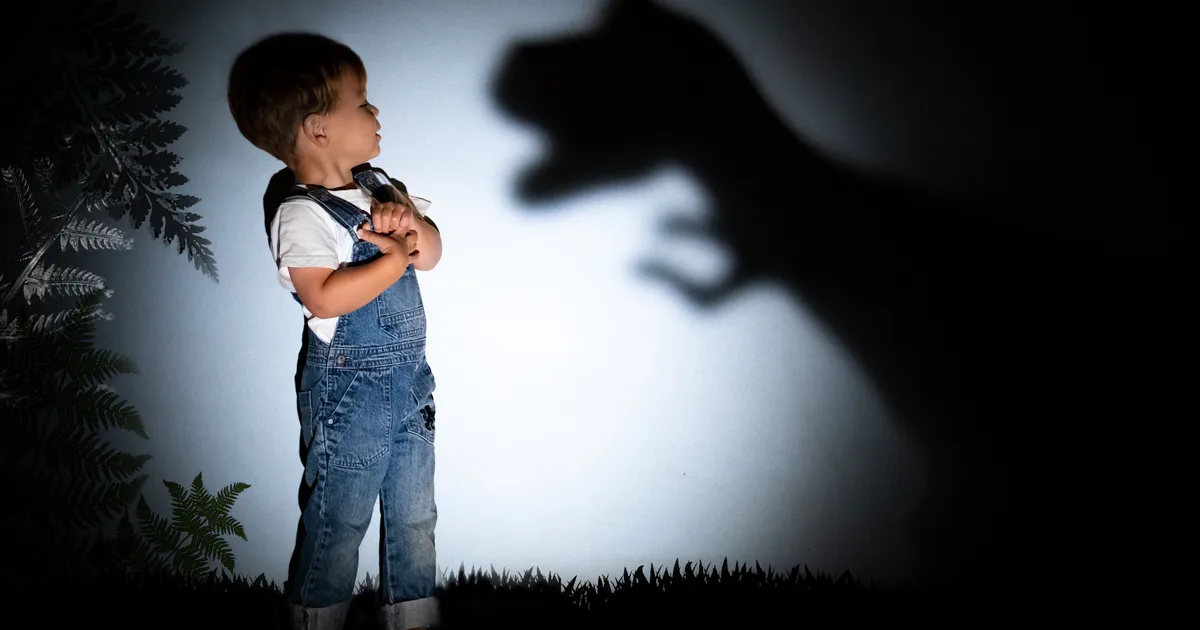Copyright HuffPost

Raise your hand if your child has experienced fears at bedtime that a monster might be lurking somewhere in their room, perhaps under the bed or hidden in a nearby closet. It turns out there’s a specific name for that fear: teraphobia (fear of monsters). And it’s one of many common phobias that impact kids. Others include fear of dogs, fear of vomiting and fear of the dark, to name a few. As parents, we do our best to help children navigate these types of challenges, but it can also sometimes be perplexing trying to figure out how to help most effectively. Advertisement “Parents can get overwhelmed when they try everything in their arsenal of commonly used support strategies, only to produce very little result in alleviating these fears,” licensed therapist Sarah Kipnes told HuffPost. If this sounds familiar, read on for a look at some of the most common phobias your child may experience, what may be behind the phobia and how to help. Advertisement Common Phobias In Kids Before diving into specific phobias, it’s important to understand that the causes of fears and anxieties in children are often outside our control and can range from genetic to environmental, explained Megan Jeffreys, a pediatric psychologist at Phoenix Children’s. “Several factors contribute to the development of specific phobias overall,” Jefferys said. “First, some children have a biological vulnerability to the development of anxiety disorders. Having a parent with an anxiety disorder makes a child more likely to develop a phobia.” In addition, learning history, (in other words, a child’s lived experience), can play a role in whether a child develops a phobia and the shape that it takes, Jeffreys added. Advertisement Here are some of the phobias that genetics or environmental exposures can trigger. Emetophobia: Fear Of Vomiting One of the most common phobias that pediatric and adult neuropsychologist Kimberly Williams sees in her patients is emetophobia — the intense fear of vomiting. This fear is typically caused by a child having an especially bad vomiting incident themselves, or they may have witnessed someone else vomiting and have been horrified by what they saw. Emetophobia may also develop spontaneously. “This phobia can take over a child’s life and disrupt daily life, everything from school attendance, to social outings or even simple family dinners,” Williams said. “From that initial experience, the brain pairs nausea with danger and the fear loop begins,” Williams added. “Children with emetophobia shift from not only worrying about vomiting, but about anything they associate with making them feel sick. For instance, they may refuse to ride in the car due to fear of motion sickness and may avoid certain foods they associate with nausea.” Advertisement Nyctophobia: Fear Of The Dark To be fair, what parent hasn’t had a child express fear of the dark at some point? The question is, when does this fear cross into phobia? “This usually begins to become problematic as a child’s imagination continues to develop. I usually see it between the ages of 3 and 6,” said Zishan Khan, a board-certified child, adolescent and adult psychiatrist. “Just to be clear, this isn’t referring to a child who is simply uncomfortable being alone in a dark room. It often results from an exposure to scary stories, movies or even conversations they overhear from others.” “This leads to them catastrophizing in their minds what is potentially going to happen when they are unable to see clearly in a darkened space and can be crippling in terms of intensity,” added Khan. Advertisement Cynophobia: Fear Of Dogs A phobia of Rover or Fido? Say it isn’t so. Sadly, it’s not unusual for children to develop a fear of dogs, known as cynophobia, after having a direct negative interaction such as being barked at, jumped on or bitten, said Kipnes. “It can also develop without direct experience, through observing someone else’s fearful reaction to dogs or hearing scary stories about dog attacks,” explained Kipnes. “Young children may also be frightened by dogs simply because of their unpredictable movements, loud barking or size relative to the child. The fear can generalize from one scary encounter to all dogs, regardless of size or temperament.” Trypanophobia: Fear Of Needles As nearly any parent can attest, few children are thrilled about the idea of getting a shot. But in some cases, this lack of enthusiasm can progress from a simple fear to a severe needle phobia known as trypanophobia. Advertisement “No child is a fan of experiencing needles, but we would say it becomes a phobia when the level of distress is making it hard to have normal pediatrician appointments because the child is so distressed about the potential of experiencing a blood draw, vaccine or other needle,” according to Ferdinando Palumbo, a pediatric anxiety specialist. “It’s one thing for a child to be distressed about needles; it’s another matter, though, when a child is avoiding needles at all costs.” This phobia, which impacts as much as 10% of the population, typically becomes apparent when a child is about 5 and a half years old, but often will decrease the older a child gets. By 10 or 12 years old, it is far less common. Teraphobia: Fear Of Monsters Bringing this list full circle, the common childhood fear of monsters has inspired more than a few storybooks and even movies. This particular phobia may show up in the form of a child experiencing an onset of insomnia or not wanting to venture outside in the dark. Teraphobia impacts kids from preschool age to elementary school, but typically wanes as they grow. Advertisement Still, when a child is in the thick of experiencing this fear, it’s important for parents to take it seriously, said Kathy Richardson, assistant professor of clinical mental health counseling at Lebanon Valley College. “Remember that young children cannot think logically, but their imagination is growing by leaps and bounds,” said Richardson. “This means that parents need to equip young children with tools to deal with these fears.” Helping Your Child Cope With Phobias A child experiencing a phobia will typically do their best to avoid the issue that causes their fear or anxiety. But experts recommend that, to gain control of the phobia, it’s best to face it. Advertisement “Anxiety disorders, broadly, and specific phobias, in particular, are maintained through a cycle of avoidance,” explained Jeffreys. “For instance, if a child is afraid dogs will bite them, then goes out of their way to avoid dogs, they do not have the opportunity to learn that most dogs are safe and maybe even fun to play with.” When psychologists treat specific phobias, their goal is to help a child learn that the object of their phobia is safe. Typically, this is accomplished via gradual exposure to the feared object. As a parent, gently helping your child to face their fears is key to overcoming them. But this should be done in a way that gives the child a choice about whether to participate in the activity, while also ensuring a level of fear low enough for the experience to be positive. Advertisement “For a child with a fear of dogs, one recommendation is to spend time being in a room with a small dog on a leash before introducing a larger dog like a golden retriever,” added Jeffreys. “Parents can also serve as effective role models to help reassure a child that a situation is safe. For example, if a child sees their parent petting a dog, it helps provide the reassurance that it is safe to pet the dog.” Reward bravery: Incorporating rewards for a child’s brave behavior can be a helpful technique because it can be exciting when a child faces their fear and earns a cool prize for being brave. Validate your child’s emotions: As adults, it’s easy to see that these fears aren’t entirely based in reality — but children don’t yet have the perspective to know that. “While it can be tempting to reassure them that ‘it’s not a big deal,’ minimizing their fear often makes it worse,” said Sophia Pierce, a clinical child and adolescent psychologist. “Instead, try saying things like, ‘I can see how scared you feel.’ Naming what they’re feeling helps children feel seen, safe and contained.” Experiment with playful interventions: Is your child experiencing teraphobia? Try pretending to spray monster spray or conduct nightly monster checks. This provides routine and gives your child a sense of control over their fear. When To Seek Backup While we do our best as parents to help our children overcome fears and anxieties, sometimes, professional help is needed. But how do you know when to reach out to a professional? YourSupportMakes The Story Your SupportFuelsOur Mission Your SupportFuelsOur Mission Join Those Who Make It Possible HuffPost stands apart because we report for the people, not the powerful. Our journalism is fearless, inclusive, and unfiltered. Join the membership program and help strengthen news that puts people first. We remain committed to providing you with the unflinching, fact-based journalism everyone deserves. Thank you again for your support along the way. We’re truly grateful for readers like you! Your initial support helped get us here and bolstered our newsroom, which kept us strong during uncertain times. Now as we continue, we need your help more than ever. We hope you will join us once again. We remain committed to providing you with the unflinching, fact-based journalism everyone deserves. Thank you again for your support along the way. We’re truly grateful for readers like you! Your initial support helped get us here and bolstered our newsroom, which kept us strong during uncertain times. Now as we continue, we need your help more than ever. We hope you will join us once again. Support HuffPost Already contributed? Log in to hide these messages. It can be a good idea to consider getting extra support if, as a parent, you’re unable to successfully help a child overcome the phobia on your own. Additionally, if the issue increases over time despite all your efforts, or lasts for more than six months, professional help may be warranted. Advertisement “If a child’s fears begin to interfere with their daily functioning to the point that they are having trouble sleeping, going to school or eating, it may be time to reach out for additional support,” Richardson said.



